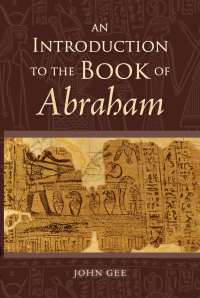Contents of the Book of Abraham
To understand the contents of the Book of Abraham, it is useful to have an outline. Because we do not have all of the Book of Abraham that Joseph Smith translated, however, it is difficult to outline the work as a whole. There are three overlapping outlines in the Book of Abraham: what Abraham actually said in the text we have, what Abraham said he intended to include in the text, and the illustrations accompanying the text.
We can outline the text of the published version of the Book of Abraham into ten sections:
I. The introduction, in which Abraham introduces himself and states what his goals are (Abraham 1:1–4)
II. The attempted sacrifice of Abraham (Abraham 1:5–20)
III. An excursus about what Abraham knows about the origin of Egypt and the pharaohs (Abraham 1:21–31)
IV. Abraham’s covenant (Abraham 2:1–13)
V. Abraham’s departure from Haran and initial sojourn in the land of Canaan (Abraham 2:14–20)
VI. Abraham’s decision to go to Egypt and God’s warning to him to claim Sarah as his sister (Abraham 2:21–25)
VII. Abraham’s night vision in which God teaches him astronomy (Abraham 3:1–18)
VIII. Abraham’s vision of the preexistence (Abraham 3:19–28)
IX. Abraham’s vision of the Creation (Abraham 4)
X. The prologue to the garden story (Abraham 5)
That was all of the Book of Abraham that was published. (To judge by the frequency of citation and use, the eighth and fourth sections of the Book of Abraham—in that order—are the most important to Latter-day Saints. The other sections are rarely used.)
In addition, the Book of Abraham itself provides a prospective outline of its contents at the end of the first chapter: “a knowledge of the beginning of creation, and also of the planets, and of the stars, as they were made known unto the fathers have I kept even unto this day, and I shall endeavor to write some of these things upon this record” (Abraham 1:31).
The facsimiles also provide an outline of sorts for the Book of Abraham. The facsimiles are put in an order that indicates points of the story that they were meant to illustrate, even though the published portion of the Book of Abraham only covers one of those illustrations. They depict the attempted sacrifice of Abraham, some of Abraham’s teachings on astronomy, and Abraham teaching astronomy in Pharaoh’s court.
Put together, these provide an outline of at least the first part of the intended Book of Abraham:
| Current Book of Abraham | Internal outline | Facsimiles |
| Introduction (Abraham 1:1–4) | ||
| Attempted Sacrifice of Abraham (Abraham 1:5–20) | Attempted Sacrifice of Abraham | |
| Egypt and the Pharaohs (Abraham 1:21–31) | ||
| Abraham’s Covenant (Abraham 2:1–13) | ||
| Sojourn in Canaan (Abraham 2:14–20) | ||
| Decision to go to Egypt (Abraham 2:21–25) | ||
| Abraham’s Vision I: Astronomy (Abraham 3:1–18) | ||
| Abraham’s Vision II: Preexistence and Council in Heaven (Abraham 3:19–28) | ||
| Abraham’s Vision III: Creation (Abraham 4) | Beginning of Creation | |
| Abraham’s Vision IV: Garden Story (Abraham 5) | ||
| Planets and Stars | Teachings on Astronomy | |
| Abraham in Pharaoh’s Court |
The outline shows that the Book of Abraham was projected to contain more than what was actually published. Given the narrative needed to discuss some of the intended subjects, it may have been significantly more than what was published.
One of the major themes in the Book of Abraham is obedience. This theme starts in the introduction when Abraham says that he had been “a follower of righteousness, desiring also . . . to be a greater follower of righteousness, . . . and to keep the commandments of God” (Abraham 1:2). When God asks Abraham to leave his family, Abraham reasons, “Thou didst send thine angel to deliver me from the gods of Elkenah, and I will do well to hearken unto thy voice” (Abraham 2:13). When Abraham is shown the council of the gods before the world was, he is told that an earth would be made so that “we will prove them herewith, to see if they will do all things whatsoever the Lord their God shall command them” (Abraham 3:25). During the Creation, the Gods ordered and then “saw that they were obeyed” (Abraham 4:10, 12), or “the Gods watched those things which they had ordered until they obeyed” (Abraham 4:18), or “the Gods saw they would obey” (Abraham 4:25), or even “the Gods saw that they would be obeyed” (Abraham 4:21). And again, “they shall be very obedient” (Abraham 4:31).
One could speculate that if we had the full Book of Abraham, the obedience theme would culminate in the sacrifice of Isaac, but unfortunately there is no way to substantiate the thought.
With a general knowledge of the Book of Abraham, including hints at what was in the fuller Book of Abraham, the question arises as to whether ancient Egyptians might plausibly have had such a book.
